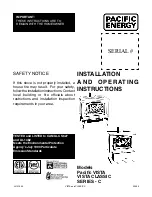
18
The amount of visible smoke being produced can be an effective method of determining how efficiently
the combustion process is taking place at the given settings. Visible smoke consist of unburned fuel and
moisture leaving your stove. Learn to adjust the air settings of your specific unit to produce the smallest
amount of visible smoke. Wood that has not been seasoned properly and has a high wood moisture content
will produce excess visible smoke and burn poorly.
WARNINGS
•
NEVER OVERFIRE YOUR STOVE. IF ANY PART OF THE STOVE STARTS TO GLOW RED, OVER FIRING IS
HAPPENING. READJUST THE AIR INTAKE CONTROL AT A LOWER SETTING.
•
THE INSTALLATION OF A LOG CRADLE OR GRATES IS NOT RECOMMENDED IN YOUR WOOD STOVE. BUILD
FIRE DIRECTLY ON FIREBRICK.
•
NEVER PUT WOOD ABOVE THE FIREBRICK LINING OF THE FIREBOX.
•
ATTEMPTS TO ACHIEVE HEAT OUTPUT RATES THAT EXCEED HEATER DESIGN SPECIFICATIONS CAN RESULT IN
PERMANENT DAMAGE TO THE HEATER.
OPERATION
Controlled combustion is the most efficient technique for wood heating because it enables you to select
the type of combustion you want for each given situation. The wood will burn slowly if the wood stove air
intake control is adjusted to reduce the oxygen supply in the combustion chamber to a minimum. On the
other hand, wood will burn quickly if the air control is adjusted to admit a larger quantity of oxygen in the
combustion chamber. The air intake control on your stove is very simple. If you pull on it out completely
towards you, it is fully open. If you push on it until it stops the combustion air is reduced to a minimum. Real
operating conditions may give very different results than those obtained during testing according to the
species of wood used, its moisture content, the size and density of the pieces, the length of the chimney,
altitude and outside temperature.
Efficiencies can be based on either the lower heating value (LHV) or the higher heating value (HHV) of
the fuel. The lower heating value is when water leaves the combustion process as a vapor, in the case of
woodstoves the moisture in the wood being burned leaves the stove as a vapor. The higher heating value
is when water leaves the combustion process completely condensed. In the case of woodstoves this would
assume the exhaust gases are room temperature when leaving the system, and therefore calculations using
this heating value consider the heat going up the chimney as lost energy. Therefore, efficiency calculated
using the lower heating value of wood will be higher than efficiency calculated using the higher heating
value. In the United States all woodstove efficiencies should be calculated using the higher heating value.
The best way to achieve optimum efficiencies is to learn the burn characteristic of you appliance and
burn well-seasoned wood. Higher burn rates are not always the best heating burn rates; after a good fire is
established a lower burn rate may be a better option for efficient heating. A lower burn rate slows the flow of
usable heat out of the home through the chimney, and it also consumes less wood.
The top down method of fire building is recommended for this appliance. After making sure that the stove
air intake controls are fully open (completely pull-out towards you), Place the largest pieces of wood on the
bottom, laid in parallel and close together. Smaller pieces are placed in a second layer, crossways to the first.
A third layer of still smaller pieces is laid crossways to the second, this time with some spaces between. Then
a fourth layer of loose, small kindling and twisted newspaper sheets tops off the pile.
RELOADING
Once you have obtained a good bed of embers, you should reload the unit. In order to do so, open the air
controls to maximum a few seconds prior to opening the stove’s door. Then proceed by opening the door
very slowly; open it one or two inches for 5 to 10 seconds, before opening it completely to increase the draft
and thus eliminate the smoke which is stagnant in a state of slow combustion in the stove. Then bring the red
embers to the front of the stove and reload the unit.
For optimal operation of your wood stove, we recommend you to operate it with a wood load approximately
equivalent to the height of fire bricks.It is important to note that wood combustion consumes ambient oxygen
in the room. In the case of negative pressure, it is a good idea to allow fresh air in the room, either by opening
a window slightly or by installing a fresh air intake system on an outside wall.
Woodstove Utilization
Summary of Contents for AW180Bli
Page 27: ...27 Notes ...











































